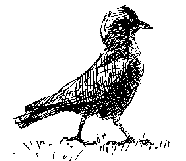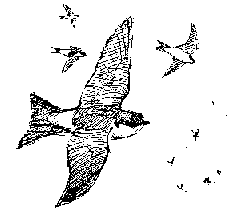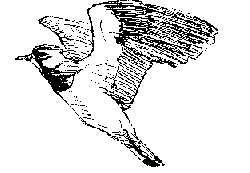Dawn chorus walks - 8th May 2005
Return to the list of reports04:30 AM
On a clear, cool and calm morning, with a light air frost, members of the Overton Biodiversity Society met in the Community Centre for a pre-dawn toast and tea before heading out around the Flashetts Nature Trail.
What was the purpose of such an early start? The opportunity to listen to and appreciate the birds taking part in the dawn chorus before most of the village rose from its' slumber.

Blackbirds, Wrens and Robins were immediately heard on leaving the Centre, the former two particularly vocal in their territorial battles. Moving down into Station Road the first Jackdaws and Rooks moved over the village, their calls hardly music to the ears but a sign that things were on the move from their overnight resting places.
Mallards, and assorted 'ducks', flew out from the filtration pools to head for local lawns and other local areas of water whilst a Sedge Warbler sung in poolside vegetation. Song Thrush, Dunnock and Goldcrest also sang the latter deep in conifers and keeping well hidden, the former sitting atop their perches as they proclaimed their presence and their intention to keep all others away from their 'patch'. Blackcaps and Chiffchaffs, possibly newly-arrived migrants but just as likely to be birds that over-wintered in the area, were warbling whereas Canada Geese could only raise a honk or two.
The paddock north of Flashetts harboured foraging Mistle Thrushes and Blackbirds and here a cock Pheasant was intent on showing off to two hens, Wood Pigeons fed amongst Rabbits whilst the lament of others, "My toe bleeds Toby", echoed from Flashetts trees. A Great Spotted Woodpecker tried to remain unobserved as it hurriedly shinned round to behind a tree trunk and a Grey Heron also put in a brief appearance, leaving quickly on our arrival at its' early morning feeding place.
Moving back down Kingsclere Road had the first Swift of the day moving overhead, as did a Pied Wagtail and four Swallows, the last already pairing up and preparing to settle down behind Town Mill and The White Hart. A Willow Warbler sung from roadside trees, appropriately willows and a Chaffinch sang from the Church zenith.
Nearing the village centre Collared Doves started to sing, Greenfinches whined nasally and the first House Sparrows and Starlings of the day finished off the first walk of the morning.
34 species of birds were recorded with 71 being in song. View the list of species here.
06:00 AM
The 06:00 start had the Sun starting to make an impact, even though much of the walk was still in the shade created by the recently leafed trees and shrubs.
On leaving the Centre the distinct drop in the number of birds singing about Winchester Street, London Road and the High Street was very obvious - the Blackbirds and Wrens seemingly having gotten the need to declare their intentions to their neighbours out of their systems and the need to feed taking more precedence now. Collared Doves were however far more active, obviously late risers!
A Swallow sang from wires over Station Road where Swift numbers were building and two Sedge Warblers could now be heard, a Whitethroat burst into song all too briefly whereas a Skylark regaled us as it moved over the Overton Hill fields. A female Pied Wagtail, possibly the bird from earlier, fed on the pathway, Mallards in front gardens and Long-tailed Tits in the scrubbier ditch undergrowth. Greenfinches were far more vocal and several birds could be seen in courtship activities. A drake Gadwall was on the river opposite Quidhampton Mill and a Sea Trout disturbed the muddy bottom as it 'flew' from our view.

Several Chiffchaffs and Blackcaps continued to vocally protect their territories along Flashetts where an immature Moorhen scuttled through streamside flora. The 'bike-pump' sound of a Great Tit betrayed its' presence though it was not seen. A shrew or mouse calling from deep in ground cover joined the list of non-birds noted. Yellow Flag, Herb Robert, White Dead-nettle and Marsh Marigolds joined the already fruiting willows and Hart's-tongue Ferns alongside the track to Flashetts Bungalow. Several Mistle Thrushes were rattling to each other near the paddock where Blackbirds, Wood Pigeons and Moorhen foraged.
The Willow Warbler continued to sing opposite Church road where several Red Campion were in flower. The trees about the allotments held singing Chiffchaff, Blackcap, Dunnock, Wood Pigeon and Chaffinch whilst the cropped turf of the church attracted Jackdaws in to feed.
A House Martin was heard over the Recreation Centre where Blackbirds and Mistle Thrushes were joined by an immature Starling on the pitches. Swallows and Swifts were active over the river and mill as the insects started to make the most of the warming weather.
33 species of birds were recorded with 68 being in song; the additions to the birds already noted being Skylark, House Martin, Whitethroat and Long-tailed Tit. View the list of species here.
07:30 AM
The last walk of the morning, still too early for many it seemed, left the Community Centre at c.07:30 to the cooing of Collared Doves, the whining of Greenfinches and the chirruping of House Sparrows using the building to nest in.
Swifts were starting to scream over Station Road whilst Goldcrests sung their high-pitched songs from deep within fir cover. Starlings were seen in display on power wires where Swallows also dropped in intermittently. The movement of Rooks and Jackdaws had all but ceased but away to the north their activities were still to be seen at Hilltop Road, the rookery there being a particular dynamic one. The drake Gadwall remained on the river and a Sedge Warbler and the Whitethroat continued to vocalise from near the filtration pools.
The wind had started to pick up as we entered Flashetts, dropping the ambient temperature even thought the Sun was now starting to clear the heavy shadows of the earlier outings. From here Pheasants were heard to call near Foxdown and the railway line adjacent to the Great North Field. Blackcaps and Chiffchaffs sung; the gently buzzing of the latter heard as it paused between snatches of song.

On moving to and south along Kingsclere Road a Lapwing was seen to fly low northwards, presumably a local breeder, and a male Bullfinch flew in towards Flashetts from the west; neither being common birds locally.
The House Martin numbers had increased as we headed back to the final finish of the day, these joining the Swallows and Swifts hawking low over the village centre; the latter now really throwing some energy into their shrieks!
35 species of birds were recorded with 56 being in song. The last additions to the list of birds noted during the three walks coming in the form of single Lapwing and Bullfinches, both seen in flight. View the list of species here.
A total of 40 bird species was recorded by the twelve that attended the walks, as were several animal and plant species, stirring insects and even less stirring locals! View the list of species here.
I would like to thank all those that took part in this new venture for the O.B.S., whether they participated in the walks or were involved behind-the-scenes with the work that helped make things run smoothly. A particularly big thank you goes to those that were out earlier than everybody else so as to prepare the breakfasts!
Return to the list of reportsPeter E. Hutchins
